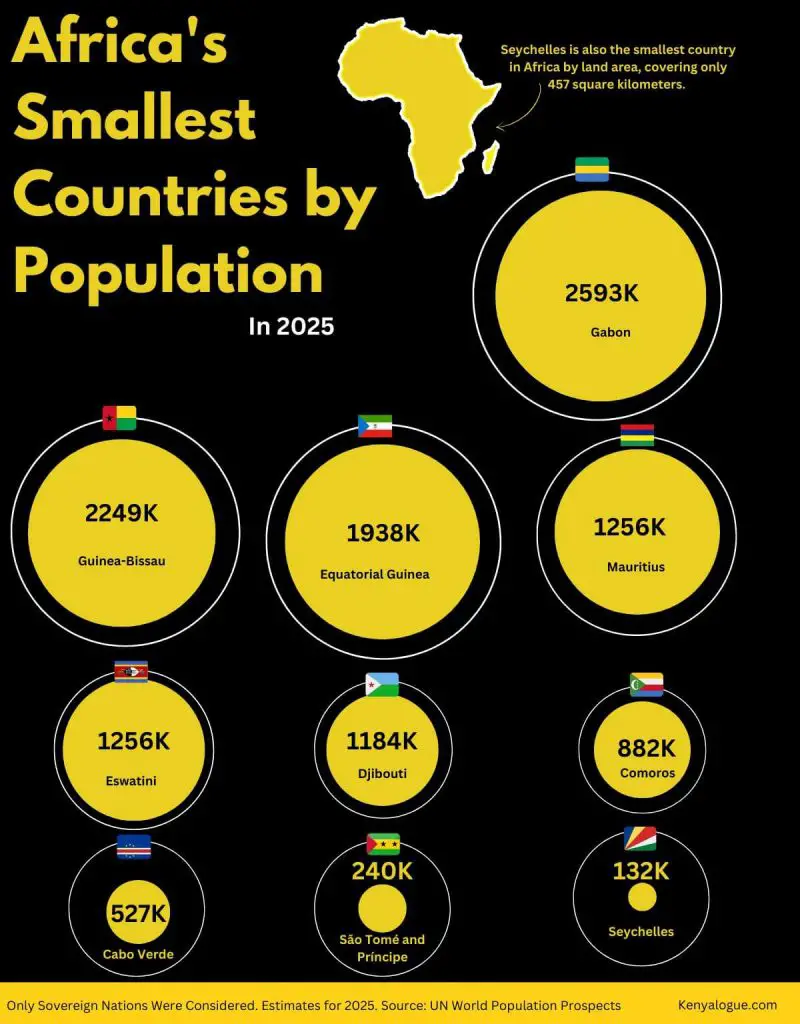
When we talk about Africa, the mind often races to its vast savannahs, bustling cities, and over 1.4 billion people spread across 54 countries. As the second-largest continent both in size and population, Africa is often examined through the lens of growth: rapid urbanization, youth booms, and mega-cities on the rise.
But what about the other end of the spectrum?
While much of the narrative centers around large nations like Nigeria and Ethiopia, there’s a fascinating story quietly unfolding in Africa’s smallest countries—at least in terms of population. These are places where life moves at a different pace, where community is tight-knit, and where size doesn’t always dictate significance.
Top 10 Least Populous African Countries in 2025
| Rank | Country | Population (2025) |
|---|---|---|
| 1 | Seychelles | 132,779 |
| 2 | São Tomé and Príncipe | 240,254 |
| 3 | Cabo Verde | 527,326 |
| 4 | Comoros | 882,847 |
| 5 | Djibouti | 1,184,076 |
| 6 | Eswatini (Swaziland) | 1,256,174 |
| 7 | Mauritius | 1,268,280 |
| 8 | Equatorial Guinea | 1,938,431 |
| 9 | Guinea-Bissau | 2,249,515 |
| 10 | Gabon | 2,593,130 |
The Smallest of the Small: Seychelles
Sitting alone atop this list is Seychelles, a pristine archipelago in the Indian Ocean with just over 132,000 residents. It’s not only Africa’s smallest nation by population, but also by land area—just 457 square kilometers. That’s smaller than many African townships. Despite its size, Seychelles punches above its weight in tourism, sustainability efforts, and marine conservation.
Island Nations Lead the Way
Notably, the top three least populated countries—Seychelles, São Tomé and Príncipe, and Cabo Verde—are all island nations. Their geographic isolation has naturally limited population growth, but these small countries also tend to develop strong service sectors, especially in tourism and fisheries. Interestingly, small populations in these countries don’t mean stagnant economies. Cabo Verde, for instance, is often cited as an African economic success story, showing that limited size can still go hand-in-hand with stability and progress.
Bigger Isn’t Always Better: The Case for Smaller Populations
In development discussions, we often highlight the downsides of overpopulation—strained resources, traffic congestion, housing crises. But what about the benefits of a smaller population?
Countries with fewer people often enjoy:
- Simplified governance and administration
- Lower levels of congestion
- Potentially stronger community bonds
- Easier implementation of sustainable policies
Mauritius, for example, with just over 1.2 million people, has managed to develop into one of Africa’s most stable and economically competitive countries, boasting strong institutions and a high Human Development Index (HDI).
Likewise, Djibouti, though often overshadowed in regional politics, has become a strategic hub due to its location on the Red Sea, hosting military bases and international logistics centers.
Challenges Behind the Tranquility
Smaller populations don’t mean fewer challenges. Many of these nations face unique vulnerabilities:
- Limited labor markets make it difficult to scale industries.
- Dependency on imports can cause economic volatility.
- Brain drain is a real concern when ambitious youth seek opportunities abroad.
- Climate risk is especially acute for island nations like Seychelles and São Tomé, where rising sea levels pose an existential threat.
Final Thoughts
Africa’s least populated nations may not make headlines as often as their larger neighbors, but they are vital pieces of the continental puzzle. They demonstrate that size doesn’t limit potential. Whether it’s Mauritius crafting a service-based economy, or Gabon leading the charge in forest preservation, these countries show that with the right policies and vision, even the smallest nations can have a mighty impact.
So next time we talk about Africa’s future, let’s not forget the voices from its smallest corners. They may just hold some of the most innovative answers to the continent’s biggest questions.
